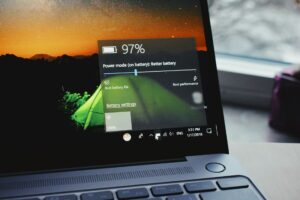Learn how to extend the life of your laptop’s battery without sacrificing its performance.

Learn how to extend the life of your laptop’s battery without sacrificing its performance.
Batteries for laptops continue to be one of the most important aspects in determining how smoothly a computer experience is delivered. Your productivity and mobility will suffer if the battery runs out of power too soon, regardless of how powerful the hardware is. It is not always necessary to compromise speed in order to achieve durability, despite the fact that many manuals recommend decreasing performance settings in order to preserve power. It is possible to considerably increase the life of a battery while keeping a high level of performance for work, entertainment, and multitasking provided you use the appropriate optimization tactics.
In this post, it is discussed how to attain this balance in a practical manner.
1. Ensure that your system is always up to date.
Updates to the operating system and drivers often contain enhancements to the power optimization algorithm. Windows 11 and macOS, for instance, both constantly provide upgrades that improve the efficiency of their battery capabilities. In a similar manner, OEMs like as Intel, AMD, and NVIDIA regularly update their drivers in order to cut down on needless energy use.
- The management of electricity in the background is improved by regular upgrades.
- Errors that might lead to increased use of the CPU or GPU are also fixed.
2. Intelligently adjust the power modes
- Instead of requiring users to make a decision between “performance” and “battery saver,” modern laptops provide the option of adjusting their power profiles.
- When you are gaming or rendering on Windows, you should only utilize the Best Performance mode. Balanced Mode should be used for everyday chores.
- Energy Saver is a feature that runs on macOS that automatically adjusts the activity of the CPU without affecting everyday performance.
You are able to maintain speed without using up an excessive amount of battery life if you allow the system to distribute resources effectively.
3. Take care of things in the background
- A great number of applications operate in the background without being noticed, using both the CPU and memory. This continuous drain shortens the lifespan of the battery.
- Utilize the Task Manager on Windows or the Activity Monitor on a Mac to locate applications that are often used.
- Deactivate any applications that aren’t absolutely essential.
- If all you need to do is read, you should make use of lightweight options such as a PDF reader rather than a complete editing suite.
- Streamlining allows you to decrease the amount of energy that is lost without compromising the primary process.
4. Adjust Display Settings to perfection
- On current laptops, the display is often the component that consumes the most battery power. Rather of reducing the resolution or shutting off elements that you need, you may attempt the following adjustments:
- The brightness should be reduced to a level that is pleasant but not maximal.
- Allow adaptive brightness to automatically adjust itself to varied lighting conditions.
- Make use of the dark mode whenever it is feasible; this mode is especially useful for OLED displays.
- By doing so, lifetime is increased without impacting the speed of the system.
5. Manage The Connections That Are Wireless
- Wi-Fi and Bluetooth are continually looking for signals, which results in an increase in energy consumption.
- When not in use, Bluetooth should be turned off.
- Disconnect from Wi-Fi networks that are not being utilized.
- While working offline, make use of the airplane mode.
- Due to the fact that network scanning does not have an impact on CPU power, this is a cost-free method of conserving battery life without compromising performance.
6. Take Advantage of the Acceleration Provided by Hardware
- Let the graphics processing unit (GPU) handle graphics-intensive operations like video playback, editing, or rendering rather than requiring the central processing unit (CPU) to do everything.
- Browsers and media players should be configured to support hardware acceleration.
- This lessens the load on the central processing unit, decreases the amount of power that is used, and speeds up the execution of operations.
- Increasing efficiency while maintaining speed is one of the most effective strategies to do this.
7. Stay away from hot buildup and excessive charging.
- Both performance and battery longevity are negatively impacted by excessive heat.
- Make sure airflow is not blocked, and if necessary, use a cooling pad.
- Hard surfaces, as opposed to soft fabric, should be used to store the laptop.
- In order to have healthy battery cycles, you should set a charging restriction for your device, such as stopping charging when the battery reaches 80%.
- When subjected to intensive usage, a laptop that is cooler operates more effectively and consumes less power.
8. Utilize Memory Management and Storage Methods That Are Efficient
- SSDs have a lower energy consumption compared to traditional hard drives. A solid-state drive (SSD) may increase the life of your laptop’s battery and enhance its performance if it is still using a hard disk drive (HDD).
- Maintain a storage space that is clear of at least 15–20% for optimal performance.
- To limit the amount of activity that occurs in the background, uninstall any applications that you are no longer using.
- Because of effective storage and memory management, your system will not spend power on operations that are moving at a sluggish pace.
9. Remember to Close the Lid Wisely
- Employing the Sleep or Hibernate modes is a more efficient alternative to shutting down the system every time.
- Although it uses very little power, the sleep mode allows you to continue your work immediately.
- The system state is saved to the disk when hibernate is in use, using nearly minimal power.
- This avoids the need for needless complete restarts, which saves battery life while maintaining the same level of performance.
10. Make Use of the Operation System’s Built-In Battery Health Features
- Battery health monitoring and optimization tools are available in both Windows and macOS operating systems.
- A comprehensive battery health report may be generated on Windows by using the powercfg /batteryreport command.
- System Preferences > Battery > Battery Health displays the current status of the battery as well as the settings that optimize it.
- You may better understand use trends and make adjustments based on that knowledge via monitoring.
11. Whenever it is feasible, upgrade.
- Upgrades to the RAM or battery are available on several laptops. You may not always be able to upgrade in ultra-thin versions, but if you use a laptop for work or gaming, you should consider upgrading:
- Runtime is increased by using a battery with a greater capacity.
- There is a reduction in dependency on virtual memory, which in turn lessens the load on the CPU and storage.
- Because of this, the performance is smoother, and the power drain is reduced.
There is no need that speed be sacrificed in order to extend the battery life of a laptop. The ability to attain both a lengthy runtime and good performance may be accomplished by concentrating on efficiency rather than restriction. The brightness of the display may be adjusted, superfluous background processes can be disabled, connection can be controlled, and heat can be managed. These are all easy measures that can make a significant impact. Monitoring the state of your battery and making use of the optimization tools provided by the manufacturer will help guarantee that it continues to work reliably over the course of many years of operation.




